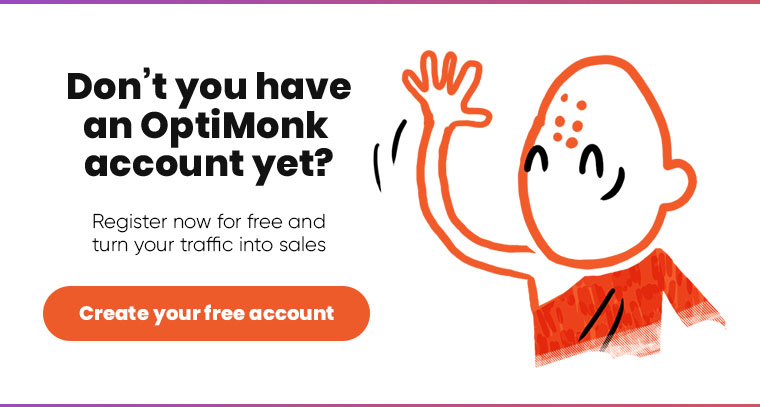- Blog
- While Supplies Last: 15 Tips to Create a Sense of Urgency & Scarcity
While Supplies Last: 15 Tips to Create a Sense of Urgency & Scarcity
-
Nikolett Lorincz
- Ecommerce
- 6 min read
Table of Contents
According to Dan Ariely, professor of psychology, fostering a sense of urgency through strict deadlines is an effective way of overcoming people’s tendency to procrastinate.
Urgency and scarcity are widely used in traditional retail, and they work for ecommerce stores, too!
In this article, we’ll look at 15 actionable tips to help you take advantage of the power of urgency and scarcity to encourage customers to buy now rather than later, boosting sales and revenue.
Why use urgency & scarcity?
Urgency and scarcity are both amazing ways to boost conversions.
- Urgency prompts customers to act quickly through a fear of missing out on a limited-time deal.
- Scarcity encourages customers to act quickly so they can get their hands on items that are scarce or in short supply.
Flash sales and messages like “buy while supplies last” are examples of how retailers use urgency and scarcity to drive sales.
There are many ways to use these psychological triggers on your ecommerce website, but the result is the same: more sales, more revenue, and more growth for your business.
Let’s take a look at some of the best tactics for increasing urgency and scarcity!
1. Set a deadline for your discounts
Everyone knows that online shoppers love to save money. And offering discounts is a great way to get price-conscious shoppers to make a purchase.
But if you offer discounts indefinitely, your customers might stop paying attention or start wondering if it’s only a “false discount.” They could even stop trusting you… and of course, if no one ever pays full price for your products, your revenue will suffer.
The best course of action is to use limited-time offers to avoid cheapening your products. This pressures visitors to buy before the offer expires.
Here’s a great example of a limited-time offer from Earthlove, displayed on an email popup:
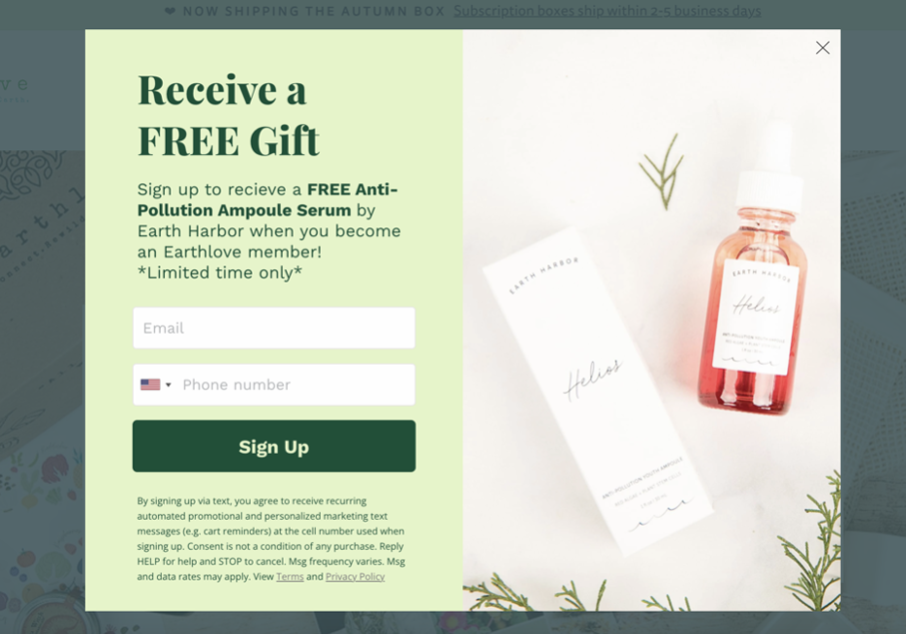
2. Use a countdown timer
When offering limited-time offers, a countdown timer is a fantastic way to increase the sense of urgency even more.
But your countdown timer has to be real. Urgency is extremely effective, but you have to use it honestly and never mislead your customers.
A storewide sticky bar with a countdown timer is a good way to promote your discount because it acts as a constant reminder of the deal.
Popups are another perfect place to use countdown timers. These quick 15-minute countdown timers are designed to stop cart abandonment and boost sales.
3. Offer daily deals
Daily deals are a great alternative to offering storewide sales. They typically give shoppers the chance to get a great deal on a specific product for 24 hours.
Best Buy applies this method very effectively.
In the example below, the fact that there are “Only 2 left” really ramps up the urgency.
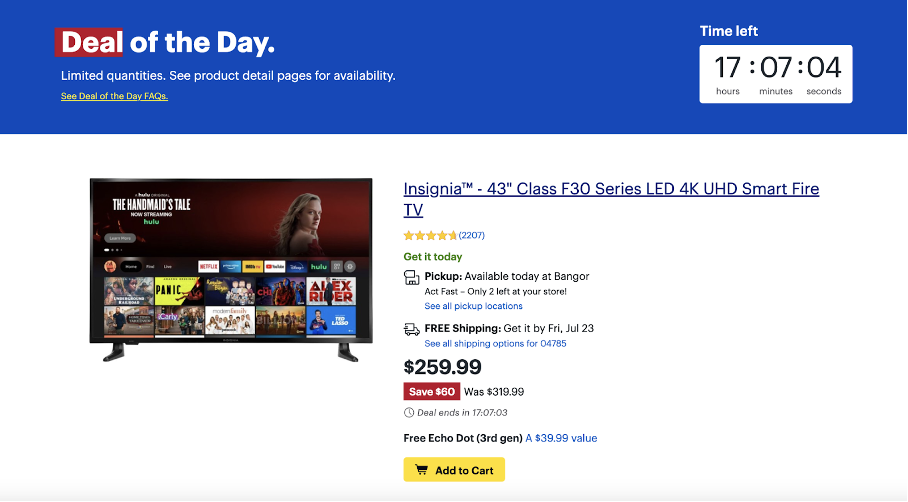
4. Use “limited quantities” and “while supplies last” wording
Highlight that you have a limited quantity of a product to pressure shoppers to buy things now.
Why does this strategy work well?
An arbitrary 12-24 hour deadline could feel forced or pushy for some customers, while saying that a product might sell out sounds more natural (and believable).
Also, it makes customers think that your products are in high demand.
Check out the example below, where ShopForWeddings offers “clearance prices” only while supplies last.
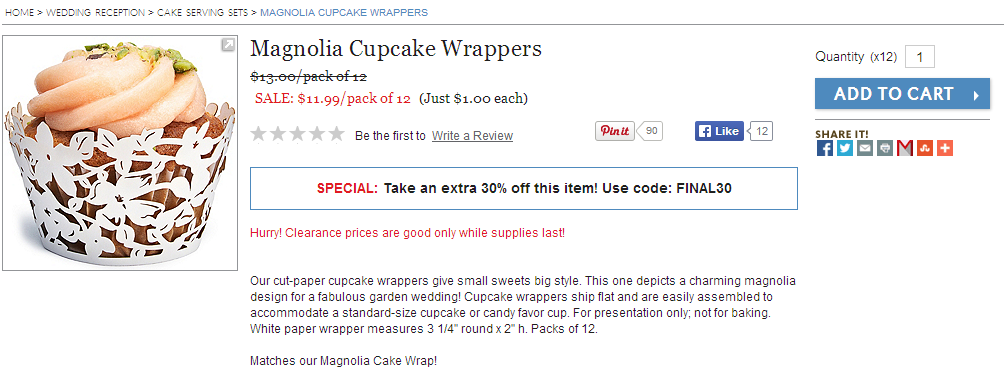
Remember, you need to be honest when you create scarcity.
Creating false scarcity when you have tons of products available in your warehouse is a bad strategy, and will likely backfire in the long run.
5. Tailor offers to customer actions
You can offer customers a personalized experience by varying the discounts and deals based on what they do.
Implementing dynamic offers can be more effective than one-size-fits-all offers when it comes to driving conversions. Dynamic offers target customers based on where they’re in the customer journey and offer different deals and incentives to first-time vs. second-time vs. loyal customers.
With this strategy, you gradually escalate the sense of urgency.
Bailly, for example, offers a discount of 10% to second-time visitors.
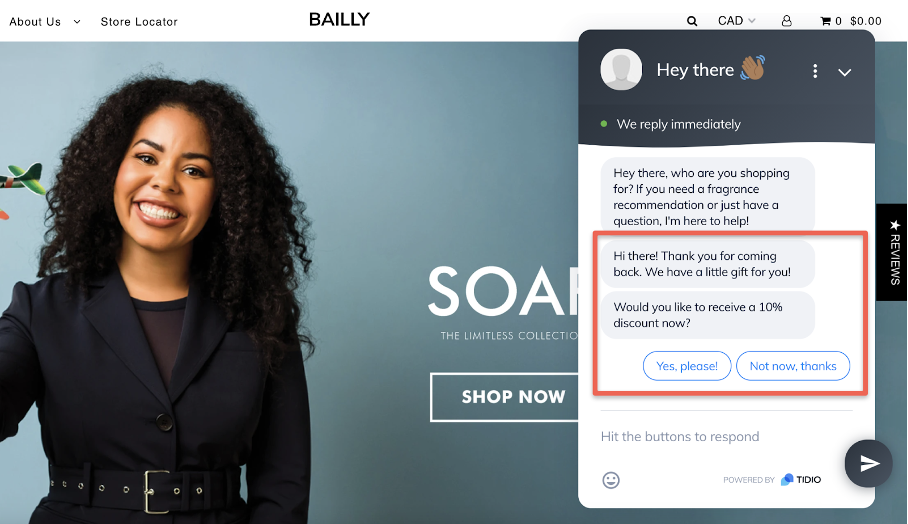
6. Advertise your sale’s deadline on the homepage
When you’re running a sitewide sale, you naturally want tons of people to take notice and shop. That’s why many online stores feature their sales on their homepage.
However, it’s also important to make customers aware that your sales are running for a limited time only.
Take a look at how Pink Lily highlights its sale on their homepage while including the deadline.
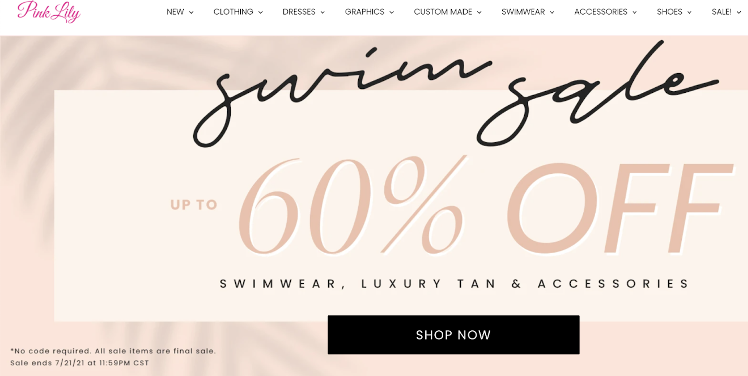
7. Provide limited-time free shipping
Unexpected shipping costs are the leading cause of shopping cart abandonment. Everyone loves free shipping, which is why offering it for a limited time tempts customers to buy now and take advantage of the deal.
1 Body makes its limited-time free shipping offer using an exit-intent popup.
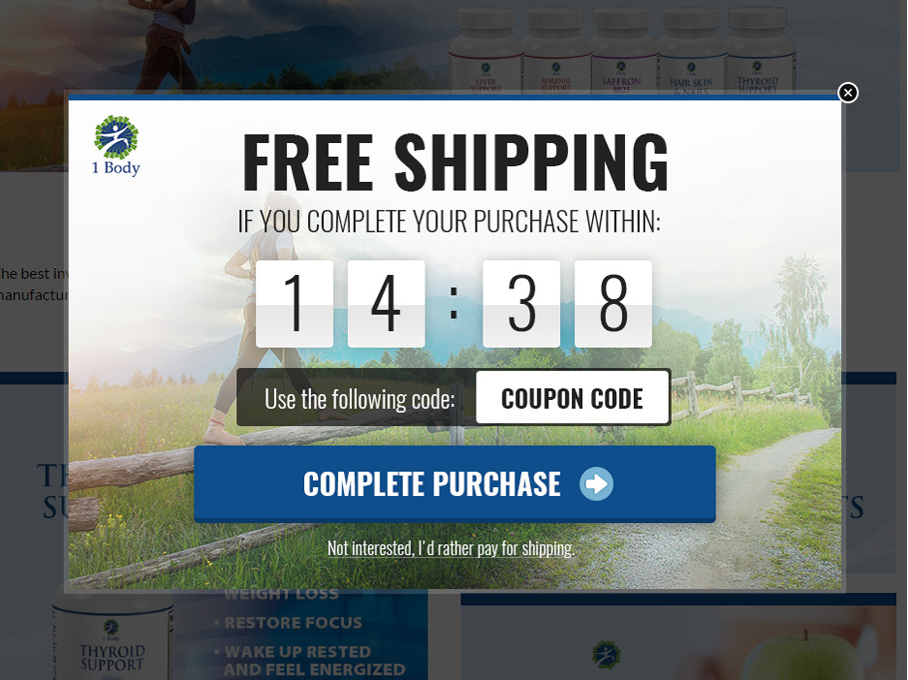
Want to try a similar approach for your business? Take a look at this popup template promoting a limited-time discount:
8. Create urgency on the cart page
Customers usually only notice the total cost of what they’ve added to their cart when they arrive at the cart page, which can sometimes cause sticker shock and discourage customers from buying.
Creating a sense of urgency or scarcity can be a good way of counteracting sticker shock. In the example below, Nike uses a simple icon and message to communicate that there’s limited stock of the product in this customer’s shopping cart.
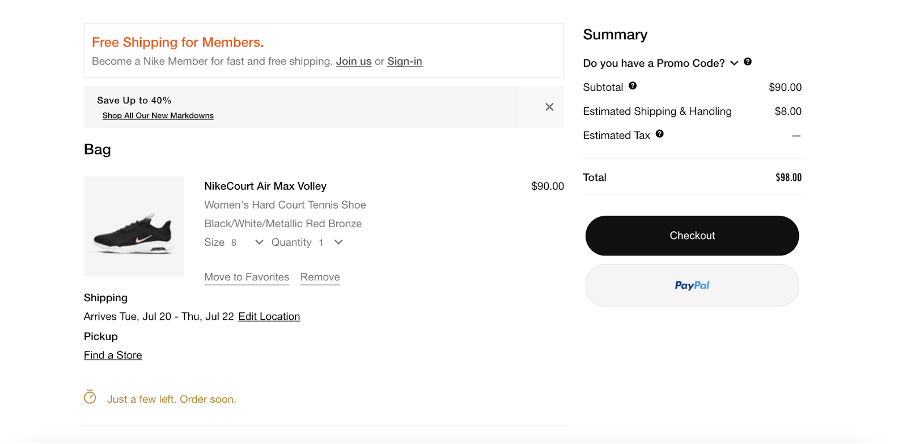
9. Use popups to provide information on limited-time promotions
Countdown timers and other messages creating urgency should be highly visible on your online store. Otherwise, visitors won’t notice them.
Using a popup to let shoppers know about your promotion is a great approach, especially if real estate on your home page is limited.
Pro tip: for popups that convert at a high rate, make sure your offer is attractive and worthy of your customers’ time. That way, they’ll view your popups as helpful and valuable rather than annoying!
Shapescale.com uses a popup that appears when people are likely to abandon their cart, and offers 10% off for the next 15 minutes.
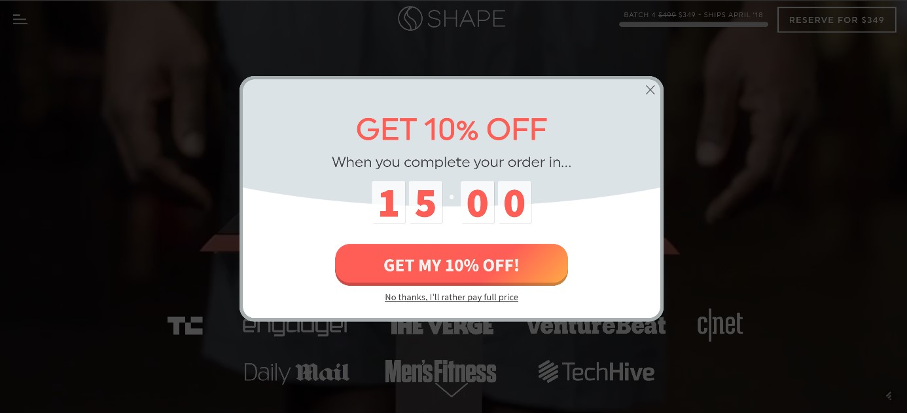
If you’d like to promote limited-time offers for cart abandoners, check out this popup template below:
10. Send email reminders
Not all your loyal shoppers visit your website every day, which is why it can be a great idea to keep them in the loop about your sales and discounts through email.
Be sure to include links to the products or categories that are on sale, and make it clear that there’s a deadline.
You can even play around with the timing of your emails. Sending emails late at night can target night owls or sleep-deprived shoppers and get you some impulse buys as sleep affects decision-making—but you didn’t hear it from us! 😉 Alternatively, you could set your emails to be triggered by certain actions your customers perform instead.
Here’s how Ted Baker reminds newsletter subscribers about their summer sale.
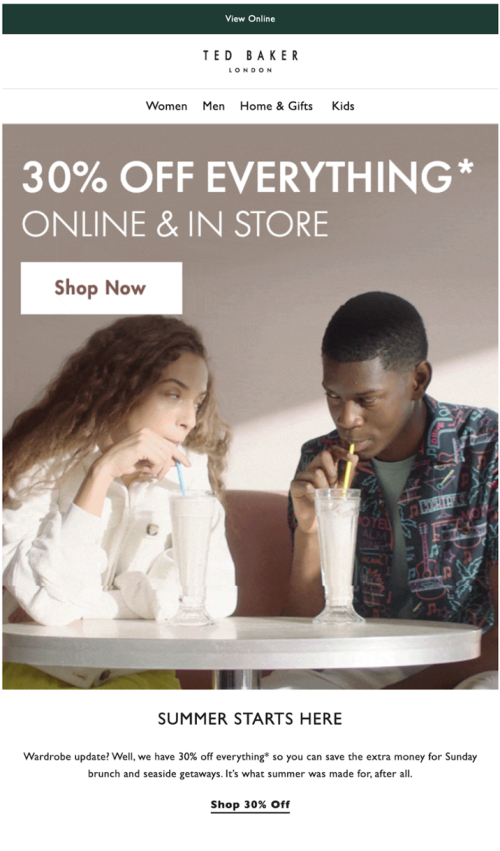
11. Show when one of your products is out of stock
Fear of missing out (FOMO) is another strong motivator for customers.
Drawing attention to the fact that items might not be available when your customer visits next instills fear, especially when they’ve found a product they really love. This makes them much more likely to take action.
Admitting that you’re out of stock for some items is a subtle yet clever way to drive conversions. Shoppers will see that some products are selling out, and they’ll be even more motivated to buy the other remaining products they’ve had their eye on while supplies last.
Rue La La is a members-only lifestyle retailer. They cleverly employ this tactic to convey a “hurry-up-before-it’s-too-late” mentality.
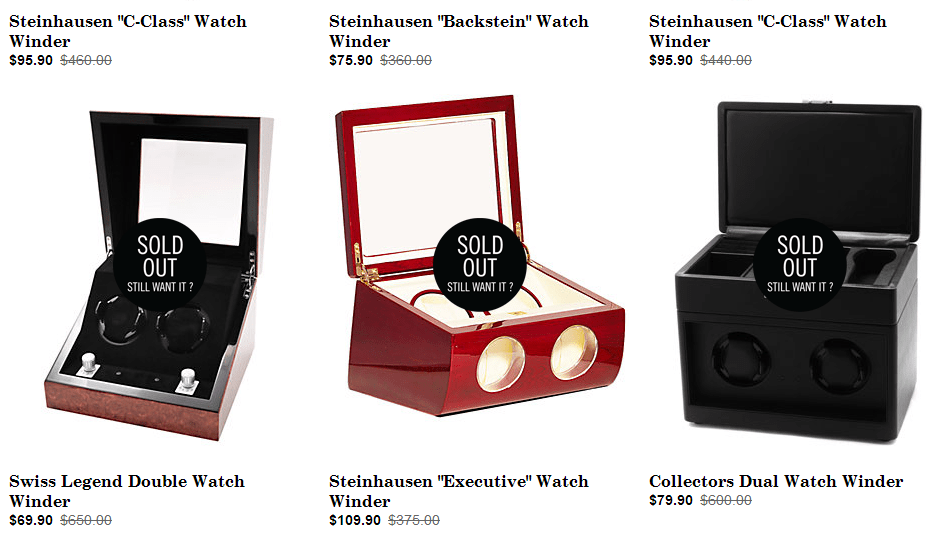
12. Show how many people are viewing the product
Calling attention to the fact that someone else is looking at a product, especially when you have limited quantities available, is a great strategy to boost sales. Competition between shoppers can heighten website visitors’ anxiety about missing out.
You could inform shoppers if an item they’re viewing is currently in someone else’s shopping cart, or you could show how many people are looking at the product at that precise moment.
Nordstorm takes advantage of this effect with a counter showing how many customers are looking at an item.
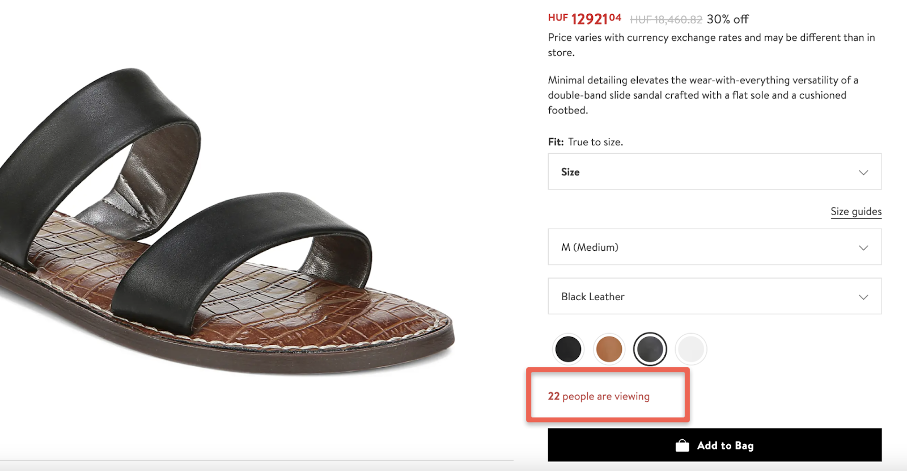
13. Use holidays to drive urgency
Seasonal campaigns work well because urgency is already baked into them. Since everyone needs to have their gifts ready by a specific date, customers are highly motivated to secure their purchase.
This is especially true for Christmas and Black Friday, but it can also work for holidays like Valentine’s Day and Mother’s Day.
14. Promote your upcoming sale
Anticipation is a very close cousin of urgency.
You can create a sense of anticipation if you tease customers about the products that will soon go on sale. They’ll look forward to the deals and be more likely to act immediately when the sale goes live.
Promoting a sale in advance might mean you sell less now (after all, many price-conscious customers will want to wait), but you’ll definitely sell more later.
See how Nordstrom informs shoppers about upcoming deals.
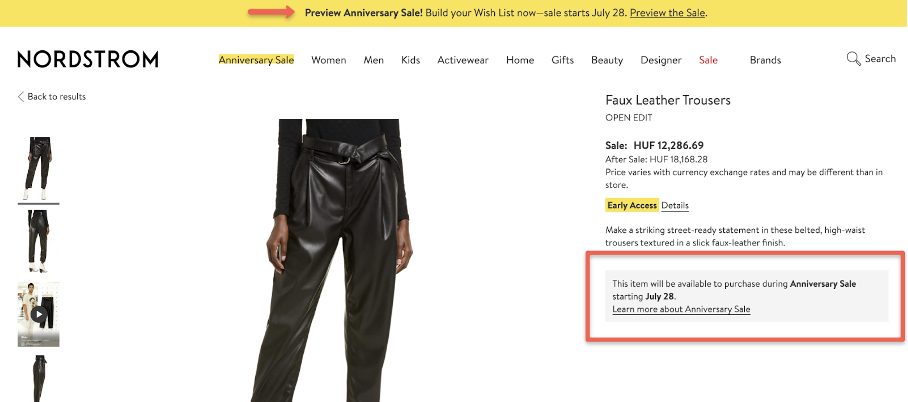
15. Play with words
Using words that pack a strong emotional punch on all your marketing materials will help to increase the sense of urgency and scarcity.
Here are a few examples you could try:
- Act now
- Clearance
- Deadline
- Don’t delay
- Don’t miss out
- Final close-out
- Hurry
- Last chance
- Limited time
- Never again
- Now or never
- Offer expires
- Once in a lifetime
- One day only
- Only
- Prices going up
- Rush
- Today only
- While supplies last
- Before the season ends
- Close-out sale
- Limited supplies available
- Hurry up, limited-time offer
- Order while supplies last
- The countdown begins
It’s important to be creative because visitors can become desensitized to repetitive messages. For example, “limited stock” is another way of saying “while supplies last.”
You can create powerful copy for your online store by combining these ideas. For instance, “Order now while supplies last” copy hits a couple of different emotional buttons, as does “Hurry Up! Limited stock available.”
FAQ
What does “while supplies last” mean?
“While supplies last” is a phrase commonly used in marketing to indicate that a particular product or promotion is available only until the remaining inventory is exhausted. Essentially, it suggests that consumers should act quickly to secure the item or offer before it runs out.
Does scarcity marketing make sense for every store?
While scarcity marketing can be effective in creating a sense of urgency and driving sales, it may not be suitable for every type of store. Factors such as the nature of the products, target audience, and brand positioning should be considered. A website offering unique or limited-edition items may find scarcity marketing more fitting, whereas it might be less effective for a store with a focus on constant availability and variety.
How can overusing scarcity negatively impact the experience of online shoppers?
Overusing scarcity tactics can lead to several negative impacts on the shopping experience. Shoppers may become skeptical if scarcity claims are perceived as exaggerated or false. Continuous scarcity promotions may also create a sense of frustration or pressure, potentially leading to dissatisfaction. Striking the right balance and ensuring authenticity is crucial to maintaining a positive shopping experience.
Wrapping up
These 15 methods of creating urgency and scarcity are all about overcoming consumers’ tendency to procrastinate about making a purchase, and they help you create an increase in demand for your products. Use the tactics above to help your online store start selling more!
If you’d like to create urgency with time-sensitive discount popups, we highly recommend creating a free OptiMonk account today. Good luck with your campaigns!
Migration has never been easier
We made switching a no-brainer with our free, white-glove onboarding service so you can get started in the blink of an eye.

What should you do next?
Thanks for reading till the end. Here are 4 ways we can help you grow your business:
Boost conversions with proven use cases
Explore our Use Case Library, filled with actionable personalization examples and step-by-step guides to unlock your website's full potential. Check out Use Case Library
Create a free OptiMonk account
Create a free OptiMonk account and easily get started with popups and conversion rate optimization. Get OptiMonk free
Get advice from a CRO expert
Schedule a personalized discovery call with one of our experts to explore how OptiMonk can help you grow your business. Book a demo
Join our weekly newsletter
Real CRO insights & marketing tips. No fluff. Straight to your inbox. Subscribe now
Nikolett Lorincz
- Posted in
- Ecommerce
Partner with us
- © OptiMonk. All rights reserved!
- Terms of Use
- Privacy Policy
- Cookie Policy
Product updates: January Release 2025









